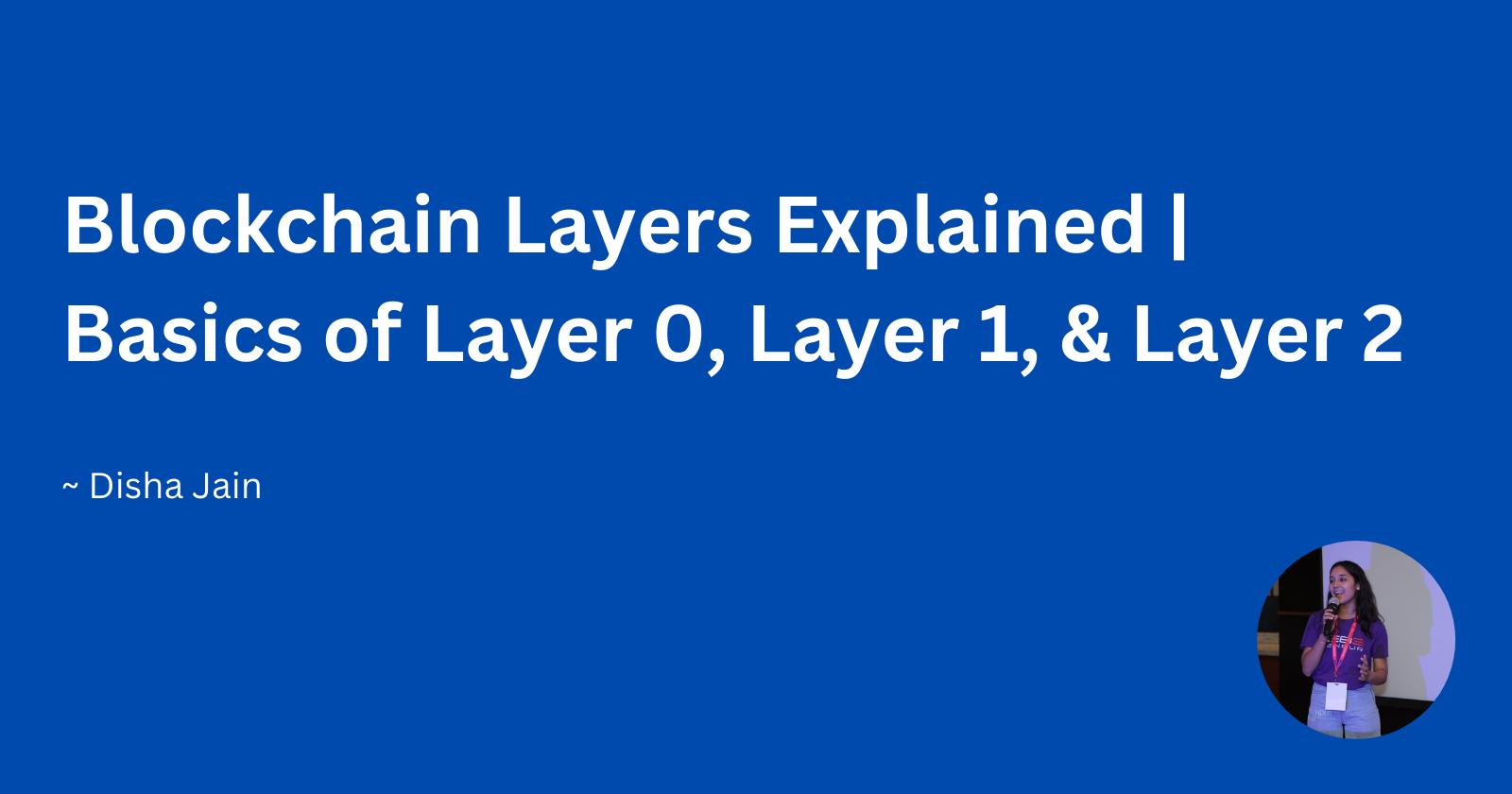Blockchain Layers Explained | Start with the Basics of Layer 0, Layer 1, and Layer 2
 Disha Jain
Disha Jain
Blockchain technology can be complex, with different layers performing unique roles in the ecosystem. To make sense of this, we'll break down the three main layers: Layer 0, Layer 1, and Layer 2. Each layer has distinct functions, use cases, and advantages, making them integral to the blockchain's operation.
Layer 0: The foundation for blockchain networks.
Layer 1: The primary layer where transactions occur.
Layer 2: Built on top of Layer 1 to improve scalability, transactions throughput and speed.
Let's dive into each of these layers and see how they contribute to the blockchain's overall functionality.
What is Layer 0?
Layer 0 is the fundamental layer that serves as the underlying infrastructure for different blockchain networks. It acts as a base upon which Layer 1 blockchains (like Bitcoin or Ethereum) can be built. The main objective of Layer 0 is to facilitate interoperability, enabling different blockchain networks to communicate and share data seamlessly.
Think of Layer 0 as the "internet of blockchains"—a universal layer that allows multiple blockchain ecosystems to interact with one another.
Key Functions of Layer 0
Interoperability: Layer 0 enables communication between different blockchains, allowing for cross-chain transactions and data sharing. This means tokens, assets, and data can move between different blockchains.
Custom Blockchain Creation: Developers can create custom blockchain networks on Layer 0 infrastructure. These custom chains can have their own unique features, consensus mechanisms, or governance structures.
Scalability Solutions: By supporting multiple chains and facilitating cross-chain communication, Layer 0 can help solve scalability issues that traditional single-chain Layer 1 blockchains face.
Shared Security Models: It often allows multiple blockchains to share a common security protocol, which enhances the overall safety of the interconnected network.
Examples of Layer 0 Networks:
Polkadot: Uses a "Relay Chain" that connects different blockchains called parachains. The parachains can have their own unique functionalities while still being able to interact with each other through the Relay Chain. This setup allows Polkadot to achieve high levels of scalability and interoperability.
Cosmos: Employs the "Tendermint Core" and the Inter-Blockchain Communication (IBC) protocol to connect various blockchain networks, known as zones. Each zone can be customized and operate independently while still communicating with other zones via the IBC.
Practical Examples of Layer 0 in Use
Cross-Chain DeFi: Imagine using a decentralized finance (DeFi) application that allows you to swap assets between different blockchains. Layer 0 would enable this by allowing the DeFi app to interact with various blockchains seamlessly.
Interoperable NFTs: Non-fungible tokens (NFTs) could be transferred and used across different blockchain networks, thanks to Layer 0's cross-chain capabilities, enhancing their utility and market reach.
What is Layer 1?
Layer 1 refers to the main blockchain protocol, where the actual data, transactions, and smart contracts are processed and recorded. It is responsible for maintaining the blockchain's security, achieving consensus among network participants, and enforcing the rules of the network. This is where the majority of the blockchain's core functions occur, including handling transactions and running decentralized applications (dApps).
Key Characteristics of Layer 1
Consensus Mechanisms Layer 1 blockchains use consensus mechanisms like Proof of Work (PoW), Proof of Stake (PoS), or other variations to achieve agreement across the network. These mechanisms ensure that all nodes on the network validate transactions correctly and maintain the integrity of the blockchain.
Transaction Processing and Validation Layer 1 networks are responsible for processing all transactions, adding them to the blockchain, and ensuring that they are secure. This means that every transaction goes through a validation process, gets bundled into blocks, and is then added to the blockchain by network participants (miners or validators).
Decentralisation One of the main goals of Layer 1 blockchains is to achieve decentralisation, where no single entity controls the network. This is accomplished by distributing the network's operations across many nodes, making it more resistant to censorship, fraud, or manipulation.
Native Cryptocurrency Layer 1 blockchains typically have their own native cryptocurrency, which is used to pay for transaction fees, incentivize network participants, and support the blockchain's economy. For example, Bitcoin (BTC) is the native currency of the Bitcoin blockchain, and Ether (ETH) is the native token of the Ethereum blockchain.
Key Challenges of Layer 1
Scalability Limitations Many Layer 1 blockchains face scalability challenges because every transaction must be processed by every node. As the number of users increases, the network can become congested, resulting in slower transaction times and higher fees. This is a significant issue for popular Layer 1 blockchains like Ethereum, where high demand leads to increased gas fees.
High Energy Consumption Blockchains using PoW, like Bitcoin, require substantial computational power to secure the network. This leads to high energy consumption and concerns about the environmental impact of mining.
Slow Transaction Speed Layer 1 networks can process only a limited number of transactions per second (TPS). For example, Bitcoin handles around 7 TPS, while Ethereum processes about 15-30 TPS. This can be a bottleneck when there is high demand for transactions.
Solutions for Layer 1 Scalability
To address scalability issues, some Layer 1 networks have implemented upgrades or changes to their protocols, including:
Sharding: Splitting the blockchain into smaller, more manageable parts (shards) that can process transactions independently. This technique is used by Ethereum 2.0 to improve scalability.
Consensus Algorithm Upgrades: Transitioning from PoW to PoS, as seen with Ethereum's move to Ethereum 2.0, to reduce energy consumption and improve efficiency.
Block Size Increase: Increasing the size of each block can allow more transactions to be processed in a single block. However, this approach can also increase centralization risks as it requires more storage and bandwidth.
Examples of Layer 1 Blockchains
Bitcoin
Uses PoW as its consensus mechanism.
Primarily used as a store of value and digital currency.
Known for its decentralization and high security but limited scalability.
Ethereum
Initially used PoW, now transitioning to PoS with Ethereum 2.0.
Supports smart contracts and decentralized applications (dApps).
Faces scalability issues but aims to solve them through upgrades like sharding and rollups.
Solana
Uses a combination of PoS and Proof of History (PoH) for faster consensus.
Known for high transaction speeds and low fees.
Designed for scalability but has faced some decentralization concerns due to fewer nodes.
What is Layer 2?
Layer 2 refers to scaling solutions that operate on top of the Layer 1 blockchain. While Layer 1 blockchains (like Bitcoin or Ethereum) focus on the core infrastructure and consensus mechanisms, Layer 2 solutions aim to alleviate network congestion and reduce transaction costs by processing transactions off the main chain, while still relying on Layer 1 for security and final settlement.
Key Functions of Layer 2
Scalability Layer 2 solutions significantly increase the transaction throughput of a blockchain by processing many transactions off the main chain. This reduces the load on the Layer 1 blockchain and allows it to handle more users and transactions simultaneously.
Reduced Transaction Costs Since transactions are processed off the main chain, the cost associated with each transaction decreases. Layer 2 solutions make it more affordable to use blockchain technology, especially for microtransactions, gaming, and other applications where high fees would be prohibitive.
Speed Enhancements By processing transactions off the Layer 1 blockchain, Layer 2 solutions can achieve faster transaction finality. This is especially beneficial for use cases like payments, gaming, or DeFi applications where quick transaction times are critical.
Security Leveraging Layer 1 Even though transactions are processed off-chain, the final settlement and security are anchored to the Layer 1 blockchain. This ensures that the Layer 2 network inherits the same level of security and decentralization as the underlying Layer 1.
Real-World Use Cases of Layer 2
Payments: The Lightning Network on Bitcoin allows for instant and low-fee payments, making it suitable for microtransactions or small everyday payments.
Decentralized Finance (DeFi): Projects like Arbitrum and Optimism allow users to perform DeFi transactions on Ethereum without facing high gas fees. Users can trade, lend, and borrow assets with quicker finality and lower costs.
Gaming and NFTs: Games and NFT platforms built on Layer 2 solutions like Polygon can handle a high volume of transactions without incurring the high costs typically associated with Layer 1 blockchains.
Imagine you want to play a blockchain-based game where every action, such as buying in-game items, requires a transaction. If these transactions were conducted on a Layer 1 blockchain like Ethereum, the high fees and slow speeds would make the game impractical to play. By using a Layer 2 solution like Polygon, these transactions can be processed quickly and with minimal fees, enhancing the overall gaming experience.
Subscribe to my newsletter
Read articles from Disha Jain directly inside your inbox. Subscribe to the newsletter, and don't miss out.
Written by
